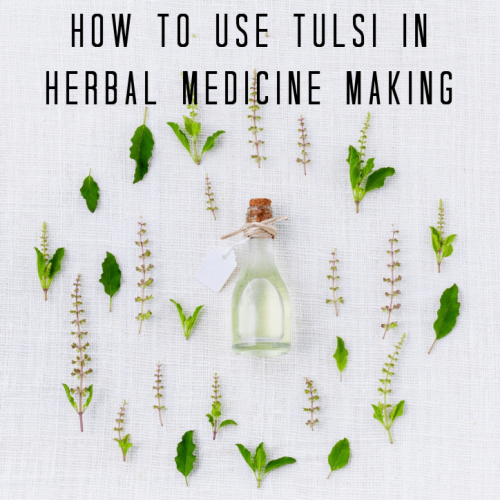
Whether you know this plant as Tulsi or Holy Basil, you will find Ocimum sanctum on the herbal medicine shelf of most herbalists around the globe.
She is a powerful tonic with a rich, and a bit dramatic, history. Tulsi is one of those herbs that always seems to show up in the most potent places of worldwide cultures – and she has quite an influence on the human species.
One of the most potent stories of Tulsi lives in the Hindu tradition. Here, our friend is associated with the preserver god Vishnu and Vrinda, his greatest devotee. Vrinda died of shock and heartbreak when Vishnu tricked her into believing he was her husband. Because of how devoted she was in life, it is said that she returned as Tulsi and no prayer to Vishnu would be complete without the plant.
In both ancient Indian culture and the ancient Egyptian culture, Tulsi was used in sacred death rituals to bathe the dead—the Egyptians even used the plant as part of their embalming process.
In cultures from Europe to the Americas, Tulsi is seen as protective in ritual and an herb to bring luck and prosperity. She is often associated with love, like in Italy where a woman will leave a pot of the holy plant on her balcony when she wants to summon her lover.
Even the Roman Orthodox Church uses holy basil in ritual. Because it is said to have been growing at the site of Christ’s crucifixion, she is revered as a connection between death, life, and rebirth.
This holy plant has stood the test of time. She encompasses thousands of years of worship for her connection with transformational perseverance. She has found a place in our hearts as a radiation of the divine that we can grow and worship and imbibe from within our own homes.
For most places in the US, Tulsi won’t love growing outside. It’s native to the warmer areas India where the soil is dark and fertile, the air is humid, and the sun is bright most of the time. You can grow Holy Basil in a pot.
She needs well draining, fertile soil – Regular potting soil mixed with perlite or sand is great. Tulsi is a little needy if you want big, luscious plants. Give her full sunlight as often as possible and watch her water levels. Don’t let her sit in water, she doesn’t like wet feet, but she shouldn’t completely dry out either. Offer her water when she’s dry about halfway down the pot – and on HER schedule (not yours).
Tulsi also should be fertilized more often than our typical houseplants do – once every month or so. Banana peel fertilizer is wonderful and very easy to make (water and banana peel, three days in the shade!)
Trim your plan often if you want her to show up bushy and produce a lot of leaves. Don’t be afraid to take off the dominate top stalk. She’ll thank you for it!
The uses of Tulsi in herbal medicine are vast. She is a tonic plant that brings a sense of harmony to any user that stays open enough to accept the transformation she is offering.
Tulsi helps tremendously with stress and adrenal fatigue over time by having a direct effect on the body’s adrenal glands. Paired with the antispasmodic and nervine action, this plant is a knock-out for short and long-term stress.
Tony, a medicine maker of the school, who has now passed away, shared his story of Tulsi.
He drank the tea everyday for months while he was in herb school. He liked the taste and it was a nice ritual for him but he hadn’t noticed too much of a difference in his attitude… that is until the school ran out and he stopped drinking it. Within a few days he felt much more affected by stress and anxiety than he had been while he was drinking it.
He promptly went back to imbibing the tea everyday – and enjoying the uses of Tulsi regularly in formulas for low grade – but constant – stress.
Tulsi is very helpful in preventing dis-ease, partially because it helps us stay calm (stress has a negative impact on our immune system) and because one of its most effective physical actions is that it’s antimicrobial.
This probably isn’t so much of a surprise coupling the high essential oil content (nature’s pest repellent) with some of the historical uses for tulsi like strewing around the home of an ill person, use during the embalming process, and being a classic herb used for soaps.
The antimicrobial action makes Holy Basil especially wonderful during a chest cold or bacterial sickness involving the lungs. This goes especially for people that are congested or achy.
This recipe makes enough chest rub for 4 people to have a standard size chest rub (about 2 ounces)
Ingredients:
1/4c beeswax
3/4c olive oil
70 drops Tulsi Essential oil
4 60ml Amber Glass Jar Pots
Directions
Melt your beeswax in a double boiler
Add the oil and essential oils
Mix well – you can also whip this for a lighter consistency
Pour into your pots still warm
Let cool.
Other optional but recommended essential oils are eucalyptus, mint, thyme, and rosemary. Play around with the scent you like if you add other oils. The total amount of essential oil in this remedy shouldn’t exceed 150 or 5 droppers full.
There isn’t really a better way to describe it.
Tulsi is associated with heat. She is a yang plant. A passionate, fiery friend that keeps the internal systems warm and working optimally. This makes her GREAT for people that present as cold or with signs of sluggishness in their liver, digestive, or reproductive systems.
The herbal actions you’re looking for here are things like diaphoretic (she makes you sweat), circulatory stimulant (moves the blood), emmenagogue (helps to start menstrual flow), carminative and bitter (stimulates digestive system), and expectorant (helps to move mucus out of the lungs). If you’re hitting a roadblock somewhere, add Holy Basil and watch her magic work.
Tulsi also gets things moving emotionally. If you’re working with someone that is physically holding on to an emotional experience, try having them meditate with a Tulsi simple for a weekend.
A flower essence is a remedy that uses just the flower of a plant to help with the connection in the subtle energies between the physical and emotional aspects of life.
The Tulsi flower essence helps to bring a greater understanding of our own nature. A client that is undergoing change or that needs a bit of help on a journey of self exploration could find that Holy Basil is just what she needs to hold space for self discovery.
This plant helps to harmonize our emotional, sexual, and spiritual lives so that we can perceive the world as part of a sacred whole. Because of this, Holy Basil flower essence is deeply effective for those that feel shame around their body or that have a hard time reconciling with their own sexuality.
Do you work with this plant? Tell us your favorite way to work with Tulsi Holy Basil in the comments!
Sources:
Much of this article is taken from an article previously written by the same author, Aubrey Wallace. In that article, she shares an anecdotal connection with Tulsi along with this information for Annmarie Skin Care
Stories from Hindu Mythology – Jalandhar and Vrinda (The story of Tulsi)
Gyanunlimited on the Health Benefits and Uses of Tulsi
Gardner, L. (2008). Life in the medicine: A guide to growing and harvesting herbs for medicine making. Sebastopol, C.A.: Emerald Earth Pub.
Alfs, M. (2003). 300 Herbs Their Indications and Contraindications. New Brighton, MN: Old Theology Book House.
Mars, B. (2007). The desktop guide to herbal medicine: The ultimate multidisciplinary reference to the amazing realm of healing plants, in a quick-study, one-stop guide. Laguna Beach, CA: Basic Health Pub.
Growing Holy Basil YouTube: https://www.youtube.com/watch?v=UOWN8xqjOKY
Support Our Work
Berkeley Herbal Center is a 501(c)(3) organization, so all donations are tax deductible. Tax ID #14-1975183
If you would like to donate by check or cash, please send an envelope addressed to:
Berkeley Herbal Center
1250 Addison St., #G
Berkeley, CA 94702

